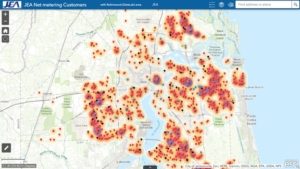
JEA is preparing for a flexible grid for power and water
With the introduction of new sources of power, both distributed and centralized, along with more frequent extreme weather conditions, utilities are looking for ways to enable a more flexible and resilient grid. Florida-based JEA, which operates in as a “sunshine state” with exposure to hurricanes, is no exception. JEA serves 466,000 electric customers, 348,000 water customers, and 271,000 wastewater customers in northeast Florida. Julio Romero Agüero is JEA’s new Chief Innovation and Transformation Officer. He has jumped right in to make that happen.
UAI recently talked to Julio about the role analytics and data will play in delivering flexibility and resiliency.
In general, how important are analytics to JEA?
Julio. Analytics are at the core of modern and future electric and water grids. We will collect large volumes of data and need automated and advanced analytics to efficiently process and analyze that data, ultimately converting it into useful information to improve system performance and overall customer experience. If we don’t do that, it will be like having a Ferrari and using it only to drive to the grocery store.
What are JEA’s immediate objectives for analytics?
Julio. One of the key motivations for the deployment of analytics is to understand the evolving expectations and needs of our customers. We want to be proactive and anticipate their needs so that we can continue being relevant for our community. Currently, 75% of JEA electric customers have smart meters and the remaining 25% are being deployed as part of our Advanced Metering Infrastructure (AMI) program. Analyzing AMI data will help us serve our community better by improving our understanding of our customers’ experience, and allow us to identify and offer additional services and products to meet their needs.
On the electric grid side, we want to use analytics to optimize operations, planning and engineering activities. Initially, our focus is on outage management and restoration. We know that new technologies and analytics can help us further improve grid performance and reliability metrics. For instance, processing last gasp messages from smart meters is already allowing us to locate outages and restore service faster. Furthermore, we have invested in advanced line sensors (fault circuit indicators) that are monitored by our control center. We are deploying about 2,900 of these sensors on our distribution feeders, they provide fault current data that is used to improve the accuracy and effectiveness of our fault location process.
JEA does a good job with descriptive analytics to keep track and explain the past performance of our system. Eventually, we want to move into predictive, prescriptive and cognitive analytics, including the utilization of artificial intelligence techniques, such as machine learning. As part of the activities of our data laboratory, our team is deploying sensors to monitor power transformers and substation equipment in a selected area of our service territory and develop descriptive and predictive analytics to evaluate asset condition. We are also designing a pilot project that would be implemented on a subset of our electric grid. The goal of this project is to develop advanced analytics to try to detect incipient fault conditions. The plan is to collect high-resolution fault current oscillography from line sensors, this data would be analyzed to identify patterns and metrics associated with specific root-causes, such as insulation failure or vegetation management issues. This information would be used to build a library of fault current signatures, if real-time sensor data matches a characteristic pattern this may be an indication of a potential incipient fault condition. The intention would be to apply artificial intelligence techniques to real-time and historical sensor data to automate the analysis. This type of advanced analytics may allow us to proactively address potential root-causes.
Where could analytics provide value in addressing the future flexible grid?
Julio. We are developing an innovation and transformation plan for the company that will address the flexible grid, including DER integration; automation, control and protection; and resiliency. Analytics will be critical to achieving the objectives of this plan. Areas that we are currently considering as part of the future include temporal and spatial load forecasting, as well as electric and water distribution state estimation.

Spatial distribution of photovoltaic (PV) generation in JEA’s service territory
For instance, spatial load forecasting would allow us to estimate potential growth not only in areas with existing electric infrastructure but also in “greenfield” areas of our service territory that are expected to be developed in the future. This is particularly important given that Jacksonville is the fastest growing city in Florida. Moreover, as DER proliferates in our system, our distribution grid will become more dynamic and bidirectional power flows will become the norm. In this scenario, temporal (time-series) load forecasting and state estimation of the distribution grid, will become very important for the reliable and secure operation of our T&D systems. This will require utilizing a variety of data sources, including AMI, Intelligent Electronic Devices (IEDs) monitored by SCADA and behind-the-meter Distributed Energy Resources (DERs). The latter is particularly challenging, because of limited observability over these assets. We are currently starting to explore DER monitoring technologies that can help us bridge this gap.
On the water distribution side, the concept of state estimation is relatively new, and no comprehensive commercial solutions are available. Our team has deployed advanced sensors in selected locations of our water distribution grid to measure key variables such as pressure and flows, and has developed innovative analytics to assess the situational awareness of the grid. We plan to continue developing these solutions with the long-term objective of estimating the state of the water distribution grid.
Please describe your vision of the most efficient and effective enabling analytics infrastructure.
Julio. We need to have the foundational infrastructure in place to feed data collected from IEDs into advanced analytics applications. This infrastructure includes robust and reliable IT and telecommunications capabilities to collect, transmit, process, and store data. These activities need to be fully automated. We will monitor and collect data from thousands of sensors, switches, reclosers, service transformers, smart meters, DERs, etc. Therefore, automation will be critical, since it is simply not feasible to use manual processes in this type of scenario. We also aim to have fully integrated information systems, so our organization can access accurate, consolidated and consistent data across the board, with the goal of enabling the implementation of advanced analytics applications.
How important is data governance to that infrastructure?
Julio. We are in the process of developing an IT and telecom strategy and roadmap for the company. Data governance is an extremely important component of this activity. We need to make sure that we have a single source of the truth for all data analytics solutions, this is a challenging endeavor that requires close coordination from a variety of stakeholders across the company. For instance, we are currently implementing a pilot project as part of our larger data governance effort; this pilot is specifically looking at DER data used by our customer, planning, operations, and asset management organizations to ensure it is accurate and consistent. This will be vital as DER adoption increases and will help us improve the efficiency of our interconnection process and engineering analyses. We are considering the creation of a Chief Data Officer position to oversee all aspects of data governance and data management in general.















